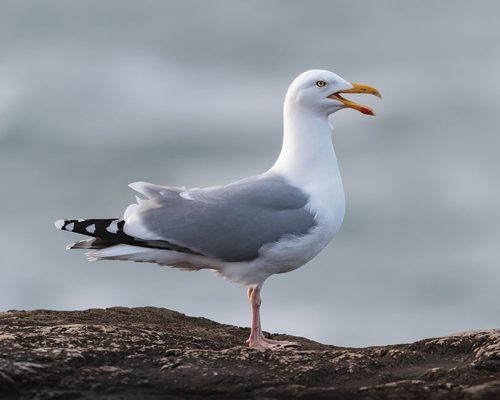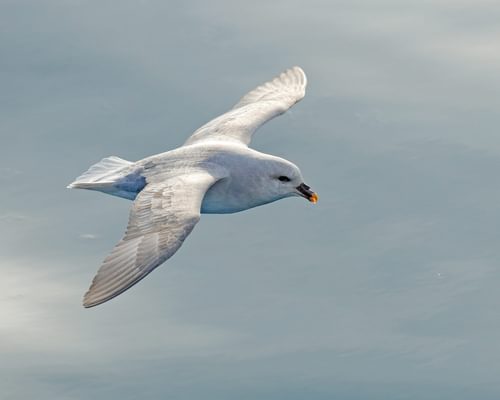Northern Gannet
Morus bassanus
Visual Identification
Appearance
The Northern Gannet is a striking seabird with predominantly white plumage, contrasting black wingtips, and a pale yellow head. Its long, pointed bill is blue-grey and has distinctive blue eye-rings.
Gannets do not show obvious sexual dimorphism, so males and females are very similar in size and appearance.
Juveniles are dark brown with white speckles, gradually becoming whiter with each moult. They take 4-5 years to develop their white adult plumage. Adults in breeding plumage display more intense yellow on their heads.
Size
Length
87cm to 100cm
Wingspan
165cm to 180cm
Weight
2.3kg to 3.6kg
Colours
Males and females have similar plumage
Primary Colour
White
Secondary Colour
Black Yellow
Beak Colour
Blue Grey
Leg Colour
Black
Habitat and Distribution
Habitats
Woodland
Garden
Wetland
Coastal
Urban
Farmland
Grassland
Desert
Tundra
Rainforest
Mountain
Savanna
Distribution
Northern Gannets inhabit the North Atlantic, breeding on rocky cliffs and islands along the coasts of Eastern Canada, Greenland, Iceland, and Western Europe.
They are particularly numerous around the British Isles, with significant colonies in Scotland. A visit to reserves like Bempton Cliffs in the northeast of England, Troup Head in Scotland or, for the more adventurous, Noup Cliffs in Orkney is recommended.
During non-breeding seasons, they disperse widely across the North Atlantic and into the Mediterranean, with some individuals reaching West Africa. In North America, they can be seen along the eastern seaboard.
Gannets can be seen off the east coast of the USA from the New England coast all the way to the Gulf of Mexico.
Elevation Range
Sea level to 200 meters
Climate zones
Temperate, Subarctic
Distribution Map
This map gives you a rough idea of where you might spot a Northern Gannet. The coloured areas show countries where these birds have been seen.
A few things to keep in mind:
- Birds might not be everywhere in the coloured areas, for example, they may be present around the coast of that country
- Where birds live can change with seasons and available food
- This map is quite simple - it doesn't show exact locations
We're working on making our maps even better! Soon, we hope to show you:
- More detailed maps for bigger countries, including state and region
- How birds move around during different seasons
Distribution by Region
Behaviour and Ecology
Bird Attributes
This feature is in beta. We'd love your feedback to improve it!
Share your thoughtsBird Attributes Explained
Our bird attributes system rates various aspects of a bird's capabilities on a scale of 0-100, based on data from field observations, scientific studies, and expert knowledge.
Attribute Categories:
- Agility: Manoeuvrability, speed, and grace in flight or movement.
- Strength: Physical power, often correlating with size and hunting abilities.
- Adaptability: Ability to thrive in various environments or changing conditions.
- Aggressiveness: Territorial behaviour and assertiveness, particularly during breeding seasons.
- Endurance: Stamina, often seen in migration patterns or foraging behaviours.
Understanding the Ratings:
- 0-20: Very Low
- 21-40: Low
- 41-60: Average
- 61-80: High
- 81-100: Very High
Remember, these attributes are relative to other bird species and don't necessarily indicate superiority.
Hover over the icon next to each attribute for more information.
Tap the icon next to each attribute for more information.
Agility
Reflects the bird's manoeuvrability, speed, and grace in flight or movement.
The Northern Gannet displays remarkable agility in its high-speed plunge-diving behaviour, capable of entering the water at speeds up to 100 km/h from heights of 30 metres. This precision diving, coupled with their ability to manoeuvre in flight and underwater, demonstrates exceptional agility.
Strength
Indicates the bird's physical power, often correlating with size and hunting abilities.
With a robust build and the ability to dive to depths of 15 metres, Northern Gannets possess considerable strength. Their large size (87-100 cm length, 2.3-3.6 kg weight) and powerful wings (165-180 cm wingspan) further indicate strong physical capabilities.
Adaptability
Represents the bird's ability to thrive in various environments or changing conditions.
Northern Gannets show good adaptability, thriving in various coastal environments from sea level to 100 metres elevation. Their ability to switch between different fish prey species and their wide distribution across the North Atlantic demonstrate adaptability, though they are primarily specialised for marine environments.
Aggressiveness
Measures the bird's territorial behaviour and assertiveness, particularly during breeding seasons.
While not typically aggressive towards humans, Northern Gannets display territorial behaviour in their dense breeding colonies. Their elaborate greeting rituals, which include bill fencing, suggest a moderate level of intra-species aggression, particularly during the breeding season.
Endurance
Reflects the bird's stamina, often seen in migration patterns or foraging behaviours.
Northern Gannets exhibit high endurance, evidenced by their long-distance foraging trips, ability to withstand harsh marine conditions, and long lifespans (up to 30 years in the wild). Their partial migratory behaviour and capacity to disperse widely across the North Atlantic further support their strong endurance.
Diet
Northern Gannets primarily feed on fish such as mackerel, herring, and sand eels. They locate prey from the air and dive into the water at high speeds, using their streamlined bodies and air sacs to absorb the impact. Gannets can dive to depths of up to 15 meters in pursuit of their prey.
Behaviour
Northern Gannets are known for their spectacular plunge-diving behaviour, plummeting from heights of up to 30 meters to catch fish. They are highly social birds, forming large, noisy colonies on coastal cliffs during the breeding season. Gannets perform elaborate greeting rituals when pairs reunite at the nest site.
Vocalisation
Northern Gannets are noisy birds, especially in their breeding colonies. Their calls include a variety of harsh, grating sounds often described as 'urrah' or 'arrr arrr'.
During courtship and nest relief, pairs engage in a rhythmic duet of guttural sounds, creating a cacophonous atmosphere in large colonies.
Nesting & Breeding
Northern Gannets form monogamous pairs and breed in dense colonies on coastal cliffs. Courtship begins in March or April, with pairs performing elaborate greeting rituals involving mutual preening and bill fencing.
Nests are built from seaweed, grass, and mud, typically on cliff ledges or flat ground. Females lay a single pale blue egg, which both parents incubate for about 44 days.
The chick is born naked but quickly develops down. It fledges after 11-13 weeks, usually in August or September, but remains dependent on its parents for several more weeks.
Conservation and Status
Global Conservation Status
While currently listed as Least Concern, Northern Gannets face threats from overfishing, which reduces their food supply, and marine pollution, particularly plastic ingestion. Climate change may also affect their breeding success and distribution.
Conservation efforts focus on protecting breeding colonies and marine habitats.
Birdwatching Tips
- Look for large white seabirds with black wingtips along coastal areas
- Observe their distinctive plunge-diving behaviour from coastal vantage points
- Visit known breeding colonies in the UK, such as Bass Rock or Bempton Cliffs, during the summer months
- Use a spotting scope to watch their social interactions in the colony
Additional Information
Quick Facts
Predators
Adult Northern Gannets have few natural predators, but eggs and chicks may fall victim to gulls, skuas, and rats in breeding colonies.
Did You Know?
- Northern Gannets can dive from heights of up to 30 meters and hit the water at speeds of 100 km/h (60 mph).
- They have special air sacs in their face and chest to cushion the impact of their high-speed dives.
- Gannets are long-lived birds, with some individuals reaching over 30 years old in the wild.
FAQs
Are Gannets greedy?
Gannets are well known for their voracious appetites. Food intake reaches a peak in the breeding season when adult Gannets are feeding their baby as much as 650 grams (1.4 lb) of regurgitated fish per day.
How deep can Gannets dive?
Gannets dive from a height of 10 - 40 meters (33 to 130 ft) above the water. They usually dive to depths of about 5 meters (16 ft) but they can dive to about 24 meters (80 ft) by flapping their wings and swimming down through the water.
How long can Gannets dive for?
Gannets typically spend less than 10 seconds under the water, although they have been recorded staying down for up to half a minute on deep dives.
Similar Birds
References
- 1 2 3
website: BirdLife International. 2018. Morus bassanus. The IUCN Red List of Threatened Species 2018: e.T22696657A132587285.
View source - 4
website, 1998: BTO Ringing Data
View source
Share Your Feedback
We value your opinion! Let us know what you think about this bird page.

